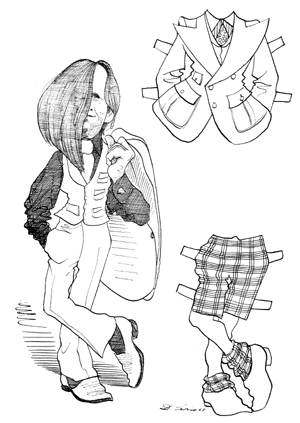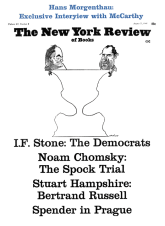Sometime during the early Sixties, trivia caught up with us all. Until then, informed awareness of the trifling or the grossly popular had been the mark of the young, hip anti-academics who, having been nurtured on comic books, soap operas, bad movies, and Orphan Annie code rings as well as the stuff of higher culture, grew up to insist that Captain Marvel and Charlie Parker were variations on The Hero with the Thousand Faces and, later, that Lenny Bruce was the most profound moral philosopher and Bob Dylan the best poet in America. After which serious people increasingly wrote seriously about popular art and style in both small and mass journals until, by the middle Sixties, we were well into a period of close analysis of junk.
Not that there is anything wrong with junk. Some of us have been immoderately addicted to it for years, remembering the words of countless popular songs, reading gossip columns and science fiction, knowing all about fashion, preferring neon to moonlight. But by now, everyone has been on to all that for quite a time and trivia has lost its cachet. It was only in the sidelong glance that gimcrackery was fun. Attend to it too much, and we see that less is less. Too bad! What new is new?
Not Tom Wolfe, certainly. Five years ago, he did appear startlingly contemporary and, at first look, original—the embodiment of the tone of Esquire and the Herald Tribune’s New York magazine both of which were, for a brief span, the snappy popularizers of the new smart pop. Wolfe swooped across their pages juggling argot, italics, dots, comic strip explosions, and rhythms until he seemed like a three-headed seal spinning disks on all three noses while he danced on a ball beneath his feet. His writing was visually noisy, a mixed medium by itself, and, for the moment, the essential new journalism—more glittering than its subjects. His first collection of essays, The Kandy-Kolored Tangerine-Flake Streamline Baby, nicely turned dross into gilt. He had a good ear for the speech of fools, a familiarity with their modes of life, and an audience which had come to believe that he was the future.
Now, three years later, Wolfe is back with two new books which run afoul of exactly that instant global communication he has so often celebrated. The Pump House Gang is a second collection of essays, most of which were written for New York, by then the magazine of the World Journal Tribune. In the two-year interval since the last of them appeared, much has changed and these essays seem shrunken, devitalized versions of themselves, much like New York magazine in its most recent incarnation as a thin, less prideful independent journal.
The phenomena which, in the old days, had set Wolfe to gasping are, today, either hopelessly familiar or already vanished: topless Carol Doda’s siliconeaugmented breasts; Hugh Hefner’s revolving bed; the film of toilet droppings shown at a fashionable party by Robert and Ethel Scull; the clothing of surfers; everybody’s hair. All yesterday’s cold potatoes—the things some people lived with the year before last.
In addition, between the first collection and the second, something happened which cannot altogether be blamed on Wolfe. Other journalists appropriated his style because it was so easy to do—using dots, italics, and expletives as a substitute for facts, a turned-on manner as a screen for sloppy thought. Now Wolfe no longer owned his own style which, divorced from its novelty, revealed its roots as romantic sports columnist newspaperese. And, writing of the status problems of the mid-Atlantic man, the fleeting youth of golden surfers, or the life of a London dolly, he unexpectedly recalls Dorothy Parker’s “Big Blonde.” So often the tough, ironic chic of one era becomes the cheap sentiment of the next.
But what really lays Wolfe low is his misjudgment of the nature of the times he documents. In his Introduction to The Pump House Gang, damning the apocalyptic intellectuals and politicians who do not understand that people are enjoying themselves, he cries, “What are you talking about? We’re in the middle of a…Happiness Explosion!”
As further evidence of the happiness explosion, we have The Electric Kool-Aid Acid Test, a painful account of an interminable trip through West Coast acid country with Ken Kesey and his band of heads, the Merry Pranksters. In other times, in other hands, this most likely would have been a novel and is, more or less, a kind of updated On The Road, even to the presence of the real Dean Moriarty, Neal Cassady, who, during the time under consideration, was still driving madly over the hills—but who has since died, some say of too much speed.
KESEY, according to Wolfe, is the seminal figure of the psychedelic movement: responsible for its utopian communes, Day-Glo art, electronic rock music, light shows, orgies, mystic communication, nut clothing, and the ingestion of drugs, drugs, drugs. Up here in the East, we tend to think of Dr. Leary as the most recent founding father, or Huxley. In any case, neither drug coteries nor mystic brotherhoods are historically unique, and the attitudes which immediately led to the Haight-Ashbury explosion had been forming for twenty years, succeeding micro-generations moving ever closer. Nevertheless, I will grant that the artifacts are probably Kesey’s, as he seems sufficiently authoritarian and manipulative to have been able to expand his private fetishes to tribal totems.
Advertisement
Both Kesey and Wolfe are obsessed by things, endlessly imbuing matter and processes with moral properties, a practice lately come into favor. Mailer speaks of frozen food as “murdered.” Plastic is a pejorative term, as opposed to glass. Iron is all right, aluminum is not. Hand-operated elevators are acceptable, but automated elevators are an indication that the plastic people are taking over (which is somewhat like considering the invention of the electric refrigerator as part of a conspiracy to remove us from human contact with the iceman). The drummers of the new are so reactionary in their insistence that what existed in their childhood is natural and what came after is artificial. Surely they must realize that even meat charred over a Bronze-age fire was processed.
I suspect that this frightened reactionary strain is what leads Wolfe to counter-phobically focus on the new. It is also possibly the force behind the psychedelic philosophy which declares, almost wishfully, that, since there are no more frontiers out there, one must go inward toward what Kesey, in a characteristic semantic turnabout, calls “edge city.” The conviction that there are no more battles to be fought outside is one which Wolfe appears to accept. He writes:
…the political thing, the whole New Left, is all of a sudden like over on the hip circuit around San Francisco, even at Berkeley, the very citadel of the Student Revolution and all.
or
The whole old-style hip life—jazz, coffee houses, civil rights, invite a spade for dinner, Vietnam—it was suddenly all dying.
Wolfe notes appreciatively Kesey’s attempt to disintegrate an enormous antiwar rally at Berkeley where, having been invited to speak, he arrived wearing a World War I helmet, likened Paul Jacobs to Mussolini, and told the crowd to stop fussing and “…just look at it, look at the war, and turn your backs and say…Fuck…it…”
KESEY swung out of Oregon in the late Fifties, coming to California to study writing at Stanford University. Although his background was affluent middle-class, he played the poor country boy for the resident intellectuals, a role he was never to relinquish. Wolfe says people would talk about Kesey like this: “I’d be delighted to listen to whatever Mr. Kesey has to say—as soon as he learns to eat from a plate without holding down his meat with his thumb.” I guess that’s what Kesey told Wolfe they used to say.
Kesey discovered the possibilities of LSD shortly thereafter, as a seventy-five-dollar-a-day participant in an experimental drug program. Wolfe writes: “He could truly see into people for the first time…the experience…the barrier between the I and the not-I disappearing…that feeling!…And you couldn’t put it into words….”
After that, Kesey went permanently aloft, even writing portions of One Flew Over the Cuckoo’s Nest (1960), zonked on acid and peyote. The novel, set in a psychiatric hospital, had as its hero Randle McMurphy, a saintly country rogue. McMurphy made real men of the inmates, grew them back to rightful size—despite the machinations of the villainous Big Nurse, keeper of electroshock, upholder of the System, and member of that Combine which stunts the growth of men, converts them to machines, and runs the world Outside.
Soon, Kesey set about becoming McMurphy in real life, establishing himself as leader and sometime paterfamilias of a widening group which included (in addition to his wife and children) people with names like Zonker, Doris Delay, Black Maria, Stark Naked (who went stark mad on a feverish, drug-suffused, cross-country bus ride), Pancho Pillow, Gretchin Fetchin, and, from the slopes of Scarsdale, Mountain Girl.
They settled in and around a house in the redwood country, painted the trees with Day-Glo paint, took movies of themselves, recorded their voices on tape, lived on stew and LSD, made friends with the Hell’s Angels, deviled the police, sewed costumes from flags, read Hesse, divined messages from the I Ching, worried about bad vibrations, let Kesey direct them to salvation, and finally tried to reclaim the unwary multitude by adding LSD to vats of punch at enormous public gatherings called Acid Tests. Some of the Merry Pranksters went over the edge of Edge City while all this salvation was going on, and there were reports that they fed acid to children. When Kesey was arrested, however, the charge was possession of marijuana—an episode which eventually led to his running away and becoming, for a time, the most celebrated fugitive in Mexico. In the end, Kesey publicly disavowed the use of LSD, served a short jail term, and retreated with his quiet wife to Oregon.
Advertisement
The whole hippie business seems about finished now and, outside Edge City, most of us are moving on to more substantial concerns. Perhaps The Electric Kool-Aid Acid Test will be the last word on the subject for a while. It is certainly a long word. Possibly, it was in order to justify and give weight to this inflated report that Wolfe attempted to tie the Kesey mythology to the origin of a new religion with Kesey as the founder, the charismatic super-hero. What Wolfe apparently did not see was that Kesey, instead of functioning as Randle McMurphy, Captain Marvel, or a messenger of God, was only the Big Nurse all along—gathering up the stray children of the middle class, blowing their minds, and keeping them small in his private cuckoo’s nest.
There is about Kesey, about the cults and flummery of the Sixties, and about Tom Wolfe, a sense of run-down motion. In these books, Wolfe has unwittingly written a kind of history under the name of prophecy. It is as if, in 1930, a herald had appeared bringing news of jazz-age babies, boyish bobs, twenty-dollar shirts, and wearing unbuckled galoshes which stylishly flapped in the wind.
This Issue
August 22, 1968




